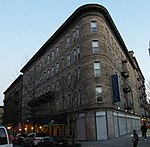St. Thomas the Apostle Church (Manhattan)
20th-century Roman Catholic church buildings in the United StatesAfrican-American Roman Catholic churchesChurches in HarlemClosed churches in New York CityClosed churches in the Roman Catholic Archdiocese of New York ... and 6 more
Gothic Revival church buildings in New York CityRoman Catholic Archdiocese of New YorkRoman Catholic churches completed in 1907Roman Catholic churches in ManhattanSalesian churchesThomas Henry Poole buildings

Church of St. Thomas the Apostle is a former Roman Catholic parish church in New York City that had been threatened with demolition. It was the subject of a landmarks preservation debate. The parish was established in 1889; staffed by the Salesians of Don Bosco from 1979 to 2003; and closed in 2003 because of a diminished congregation and structural problems. In 2013, the premises at 260-262 W. 118th St., southwest corner of St. Nicholas Avenue, in Harlem, Manhattan was sold to a private developer. After extensive renovation, the church building is now used as a concert venue.
Excerpt from the Wikipedia article St. Thomas the Apostle Church (Manhattan) (License: CC BY-SA 3.0, Authors, Images).St. Thomas the Apostle Church (Manhattan)
West 118th Street, New York Manhattan
Geographical coordinates (GPS) Address Nearby Places Show on map
Geographical coordinates (GPS)
| Latitude | Longitude |
|---|---|
| N 40.805 ° | E -73.953222222222 ° |
Address
Saint Thomas the Apostle Roman Catholic Church (historical)
West 118th Street
10026 New York, Manhattan
New York, United States
Open on Google Maps






